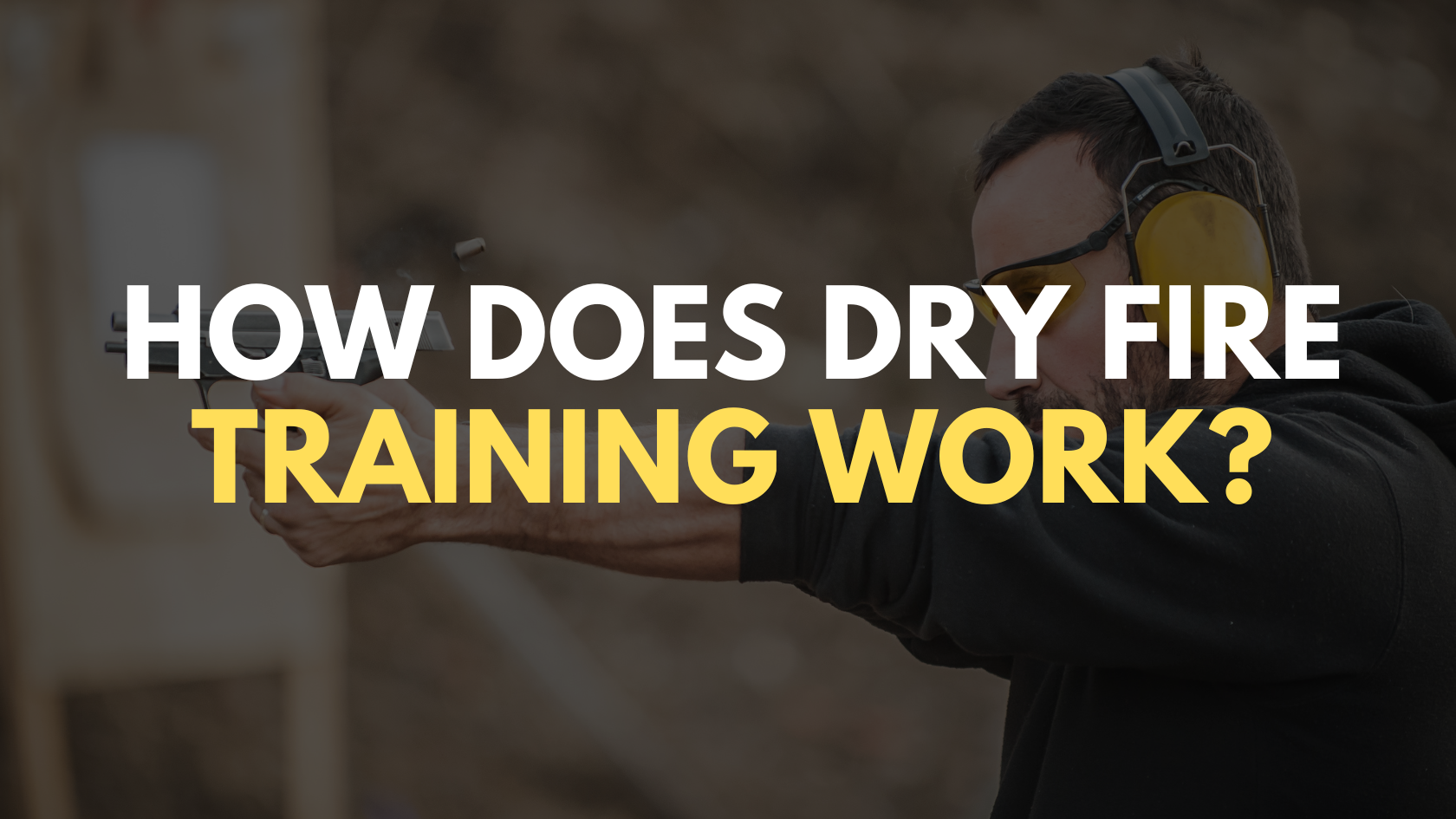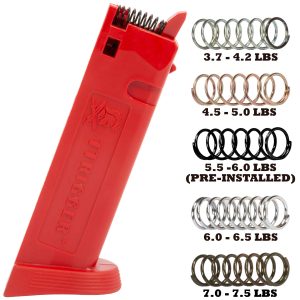
Many people who enjoy shooting weapons choose to practice their skills without using actual bullets by engaging in dry fire training. It’s a safe, supervised practice of shooting and handling firearms with an unloaded weapon or a training gun.
It’s no secret that the military, the police, and civilian gun owners all benefit from dry fire training, which has been around for quite some time. The growing interest in self-defense and the availability of training tools like online courses and instructional videos have contributed to the rise in popularity of this style of education in recent years.
In This Article, I will explain what dry fire training is, how it functions, and what advantages it offers to gun owners.
Why do we need dry fire Training?
Dry fire training is a method of practicing with firearms without actually firing them. By “dry fire,” we mean the practice of firing a firearm or training gun without any live ammo in the chamber.
In dry fire training, the shooter employs a replica or unloaded firearm to hone their skills. Practice with weapons and marksmanship can then be had without risk to the shooter or others, not to mention to property.
What is dry fire practice?
As the name suggests, dry fire training entails a series of drills and exercises meant to replicate the monotony of actual combat. Work on your grip, stance, sight image, trigger control, and follow through with these exercises. Regular practice of these methods can enhance shooting skills and establish muscle memory, making it easier to shoot correctly and rapidly even under pressure.
The following are some examples of frequent scenarios used in dry fire training:
- Training your trigger control entails learning how to pull the trigger smoothly and steadily without affecting your sight picture.
- Exercising the right stance and grip for various firearms falls under this category.
- The process of sight alignment entails training the shooter to properly align the gun’s front and back sights.
- The term “draw and presentation” refers to the practice of removing a pistol from a holster and presenting it to an adversary.
- It is important to practice reloading the pistol in a timely manner.
- The term “many targets” refers to the practice of firing at a series of targets.
The Benefits of Dry Fire Training
- Muscle memory is enhanced through repeated practice of the same drills, which facilitates the execution of shooting skills with greater ease and precision.
- With no chance of an unintended shot being fired, dry fire training is a risk-free technique to hone your shooting abilities.
- The ability to shoot accurately and with confidence can be honed by consistent practice.
- The advantage in the Field: Dry fire practice can help a person respond more quickly and accurately under pressure, providing them an advantage in the field.
dry fire training work
Training using dry fire can help identify and fix common shooting mistakes. During dry fire training, an instructor or coach can observe a trainee’s performance with a firearm and provide feedback on how to improve.
A lot of people who like shooting guns utilize a method called “dry firing” to hone their skills without actually using any live ammo. This kind of training is beneficial because it is risk-free, inexpensive, and easy to schedule. You can practice your shooting skills, from basic marksmanship to tactical shooting, with dry fire training at home or in a dedicated facility.
It is possible to improve one’s shooting skills by developing muscle memory through repetition of the same activities.
There are several options for those who want to learn more about dry fire training and include it in their shooting routine, such as books, videos, and online courses. Dry fire training is typically included in the courses offered by many firearms instructors.
Finally, if you’re looking to hone your shooting skills in a risk-free environment, dry fire training is the way to go. Regular shooting practice allows one to develop muscle memory, identify and repair shooting errors, and boost self-assurance in one’s shooting skills.
What is dry fire mag?
You can practice your dry firing skills with the help of a dry fire mag, which is a magazine made for this very purpose. There’s a little plastic insert in this magazine that stops the firing pin from damaging your gun’s chamber.
When it comes to practicing with firearms, a dry-fire magazine has many advantages. Recoil and muzzle blast are eliminated, allowing the shooter to concentrate entirely on trigger control, sight alignment, and breathing.
Accuracy Enhancement
With a dry-fire magazine, you can practice your shooting skills without having to travel to a range. Because of this, you may devote more time and effort to practicing, which in turn improves your muscle memory and precision.
Enhanced Velocity
Dry fire mag practice is a great way to get faster and more accurate with your pistol. You may quickly and repeatedly train your shooting technique, leading to quicker reactions and greater shooting speed, without having to reload after each shot.
Muscle Recall Is Improved
In order to master weapons, muscle memory is essential. You can use a dry fire magazine to hone your shooting skills and permanently imprint the necessary motions and reflexes into your muscle memory. Improving your shooting skills on the range or in a real-world circumstance is as simple as building up the necessary muscle memory.
dry fire mag could be an excellent addition to your weapon practice. You can develop greater skill and assurance as a marksman by working to increase your accuracy, speed, and muscle memory. Training with a dry fire magazine is beneficial for shooters of all skill levels.
3 Dry Fire Exercises You Can Do at Home
-
Trigger Control Exercise
One of the essential skills for shooting accuracy is trigger control. This exercise focuses on improving your trigger control, which is a vital aspect of shooting. To perform this exercise, follow the steps below:
- Clear your firearm of all ammunition and ensure that it is unloaded
- Take a comfortable shooting position
- Focus on the front sight of your firearm
- Hold the trigger back after firing the shot
- Release the trigger slowly to reset it
This exercise will help you improve your trigger control, which is critical for shooting accuracy. Practicing this exercise regularly will help you become more comfortable with your firearm. You will notice a significant improvement in your shooting skills.
-
Drawing from the Holster Exercise
Drawing from the holster is an essential skill for any firearms enthusiast. This exercise will help you improve your drawing skills, which is critical for self-defense situations. To perform this exercise, follow the steps below:
- Ensure that your firearm is clear of all ammunition and unloaded
- Take a comfortable shooting position
- Draw your firearm from the holster
- Focus on the front sight of your firearm
- Hold the trigger back after firing the shot
- Release the trigger slowly to reset it
- Re-holster your firearm
Practicing this exercise regularly will help you improve your drawing skills, which is an essential aspect of self-defense.
-
Target Acquisition Exercise
Target acquisition is an essential skill for any shooter. This exercise will help you improve your target acquisition skills, which is critical for accuracy. To perform this exercise, follow the steps below:
- Ensure that your firearm is clear of all ammunition and unloaded
- Take a comfortable shooting position
- Focus on a specific point in the room
- Raise your firearm and aim at the point
- Hold the trigger back after firing the shot
- Release the trigger slowly to reset it
- Repeat the exercise, focusing on a different point each time
Practicing this exercise regularly will help you improve your target acquisition skills, which is critical for shooting accuracy.





